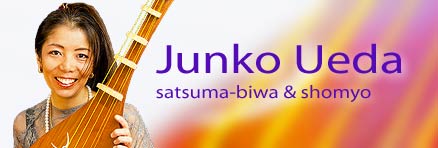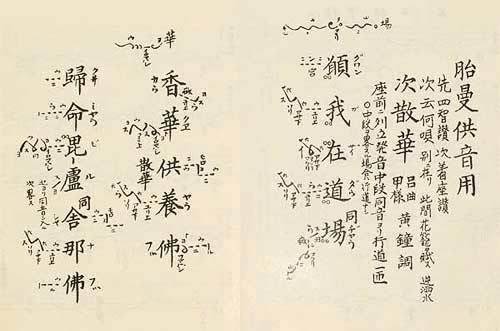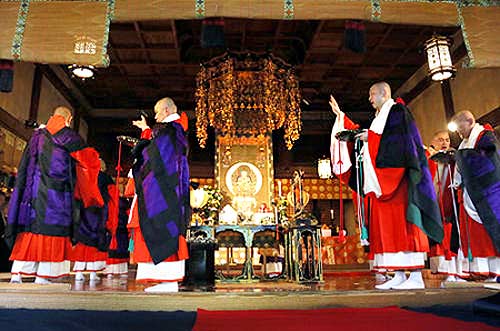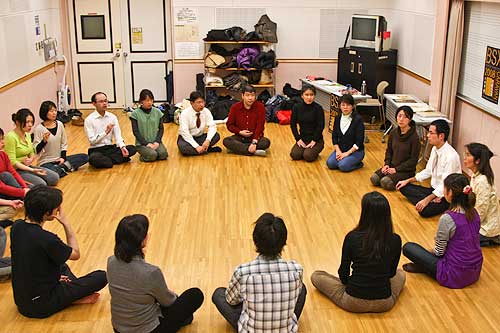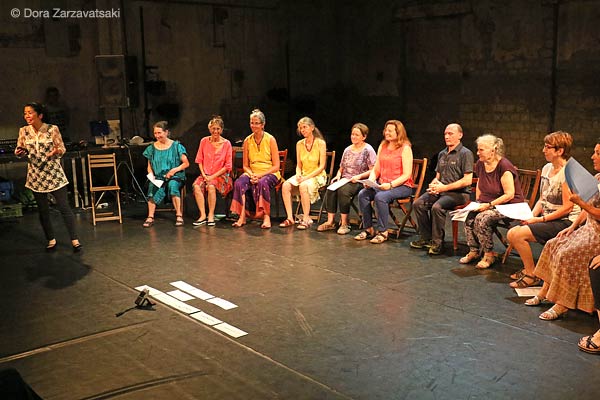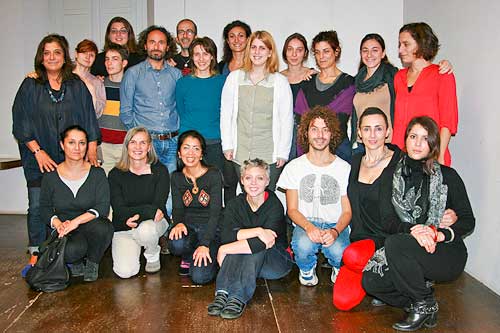Shomyo (聲明)
Aquí la información sobre el canto budista japonés Shomyo se introduce en dos capítulos.
Sobre el Shomyo
Since old times, music has been an essential part of all kinds of ritual ceremonies and also shomyo is a ritual music. It is sung in a Buddhist ceremony by a group of Buddhist monks. The original form of shomyo was practiced in ancient India and after that, through Tibet, China and Korea, it arrived in Japan.

Since then, the shomyo singing tradition in Japan is succeeded till today without any break. There is a written record that on 8th of April in 752, there was a memorial service of the inauguration of the great Buddha statue at Tôdai-ji Temple in Nara, Japan and shomyo was sung by hundreds of monks in the ceremony. Shomyo is regarded as fundamental for all later Japanese traditional music, since most of Japanese traditional music is based on singing. At the same time, it is said that shomyo has historical relations with numerous ancient song styles in the world. Literally translated, the word “shomyo” combines the characters for “voice” and “wisdom”.
Muestras de cantos budistas en Asia
A Japanese shomyo piece is constructed by melody patterns, each sung with one breath. Portamento and extended pitch-bending are one of the important elements to shape the melody patterns. Conceptually the melody patterns are regarded to remain in the space and filling the space. In this way, shomyo chanting creates its unique concept of time and space. When shomyo is sung by trained monks, their religious piety will be expressed through their voices, piling up time in the space.
Ancient Voices in a Contemporary Society
Muestra del CD 'Meditative Flowers' de Junko Ueda
 In this CD 'Meditative Flowers', Junko Ueda sings solo repertoire from the Tendai shomyo. Here below is a sound sample of the piece Kuyômon. More sound samples and information on the CD can be found at the CD page.
In this CD 'Meditative Flowers', Junko Ueda sings solo repertoire from the Tendai shomyo. Here below is a sound sample of the piece Kuyômon. More sound samples and information on the CD can be found at the CD page.Kuyômon - Junko Ueda

“When I encountered Japanese shomyo Buddhist chanting in the beginning of 1980s, I experienced an unforgettable sensation: apart from perceiving sound with the ears and the intellect, an intense mass of voices vibrated directly inside my whole body. Being captivated by shomyo chanting, I became a student of the great shomyo master Mr. Kôshin Ebihara, a celebrated monk of Tendai-shû Buddhist sect.
During these lessons, Mr. Ebihara often expressed the philosophy and the basis of his shomyo chanting: “Shomyo chanting can obviously be enjoyed as an art music. However, above all, the shomyo chanting is a most serious training and an expression of a religious feeling by a devout Buddhist person.” During years of daily practicing, one may gradually enter its profundity. While reflecting the words of the teacher, I could gradually explore some of this profundity and the significance of the shomyo chanting.
During practicing I realized that the breathing is the most essential necessity for human survival. The slow melismatic shomyo chanting makes you aware of the considerably extended length of breathing. This resembles to a religious act which gazes at the breathing as the root of human existence. Breathing is equal to the life. In other words, enjoying the breathing every moment is equal to enjoying the life. This seems to me an important message behind the shomyo chanting.
So what was that first sensation that caught me when listening to the shomyo chanting for the first time? Instead of a beautiful melody or some excellent musical virtuosity, I seemed to be touched by the power of a single breath, a power which made my body vibrate. It was the sensation of the breath ‘息’ (IKI), the spirit ‘意気’ (IKI) and the life ‘生き’ (IKI). Thinking about this, I sing shomyo once again. Then I feel thankfulness and happiness.
I would like to bring the voice of shomyo out of the Buddhist temple and to share my experience and thoughts about shomyo chanting. Also, I would like to approach to a world of universal sensitivity of human being through the expression of ‘the breath’ that has been nurtured in the Japanese culture.
The world of shomyo is extremely profound. I feel I have just started rowing out into the great ocean of shomyo chanting and it seems to take more time to be able to sail freely over this great ocean. However, exposing the power of breath in the shomyo Buddhist chanting may fill the heart of people with a moment of peace."
Junko Ueda
Repertorio de Junko Ueda
Tendai-Shomyo: Tendai-school Buddhist chanting
- Shichi-Bongo-san 四智梵語讃
- Shichi-Kango-san 四智漢語讃
- Sange (exsoteric) 散華(顕教用)乙様
- Sange (esoteric) 散華(密教用)甲用
- Taiyô 対揚
- Kuyômon 供養文
- Shoôrei 唱礼
- Kuhôben 九方便
- Godaigan 五大願
- Daisan 大讃
- Bussan 仏讃
- Hyakujisan 百字讃
- Hyakuhachisan 百八讃
- Shaten-kango-san 諸天漢語讃
- Sanrai 三礼
- Nyaraibai 如来唄
- Agekanjô 揚勧請
- rokushuekô 六種回向
- Gonenmon 五念門(十二礼)
- Sankunenbutsu 三句念仏
- Kujôshakujô 九條錫杖
- Rokudô-Kôshiki 六道講式
Taller de Shomyo

Este taller introduce el canto budista japonés Shomyo, que se origina a partir del siglo IX. Bajo la dirección de Junko Ueda, los participantes practicarán cómo cantar el Shomyo repertorios. Además de trabajar en los aspectos musicales, se adopta un enfoque holístico hacia nuestro sentido y espíritu humanos universales. Trabajamos con el tema sobre las esencias de la cultura japonesa: esas son Hara (el centro de energía del cuerpo) y Ma (espacio y tiempo). Además, los ejercicios de respiración y el ejercicio corporal (qi-gong) se introducen y se integran naturalmente en el taller. Cualquier persona puede participar en este taller ya que no se requiere ningún conocimiento musical. Puede leer más acerca de Shomyo aquí.
El objetivo del taller:
- Disfrutar de cantar juntos. Shomyo abraza las diferencias de las cualidades de voz de cada uno.
- Experimentar la música japonesa con 1200 años de antigüedad y explorar su concepto único.
- Formar conciencia y control de la respiración.
- Aprender el centro energético llamado 'Hara' (Seika-Tanden) y liberar el nivel de estrés.
- Desarrollar vocalización y control del cuerpo (ciertamente útil para los instrumentos de vientos y cantantes).

Debido a su estilo de cantar Shomyo lento y melismático, los participantes serán estimulados para concentrarse en sus respiraciones de una manera tranquila. Mientras disfrutan cantando melodías básicas de Shomyo y conociendo esta antigua tradición, descubriremos la sabiduría y el poder de la respiración y su esencia para la humanidad.
Desde 1995 Junko Ueda ha estado presentando el taller de Shomyo. A través de la promoción de estas melodías antiguas y universales, ella apoya una sostenibilidad global con pensar en buen aire como una importancia primordial para disfrutar de la respiración.
Además, Junko Ueda presenta la conferencia sobre el canto budista shomyo. Explicará su historia y concepto, y demostrará algunas de las piezas.
Muestras del sonido del taller Shomyo
Contenidos de Taller
- El calentamiento: ejercicios de la respiración y el cuerpo, enfocando la respiración y Hara.
- Introducción de Shomyo: aprendemos varios patrones melódicos de Shomyo y luego cantamos variaciones musicales usando estos patrones melódicos.
- Cantar las piezas tradicionales de Shomyo: Practicar 'Sange' y 'Taiyo '.
- introducción de su historia y varios conceptos de la cultura japonesa.
Algunas Practicas
- El taller se puede realizar una vez, como un evento único, o como una serie de más talleres.
- Duración propuesta para un taller: tres horas.
- Cantidad de participantes: 5 ~ 20 personas.
- Se recomienda a los participantes a usar cualquier estilo de ropa casual (mejor evitar los tacones y corbatas).
- Un taller puede realizarse en cualquier lugar tranquilo, con espacio suficiente para colocar sillas para los participantes en un medio círculo. Se necesita una pizarra blanca.
Feedback
- "Música muy orgánica. Me siento muy cómodo y relajado para cantar juntos.“ (Encuesta de un taller de Shomyo)
- "Un taller muy inspirador." (Encuesta de un taller de Shomyo)
- “Es increíble que tantos diferentes calidades de voz pueden estar juntos y hacen una música. No hay competencia ni estrés. Sólo puedes producir tu voz como te apetezca." (Encuesta de un taller de Shomyo)
- "Una experiencia que todo mi cuerpo está vibrando y activado de forma saludable.” (Encuesta de un taller de Shomyo)
- "De pie junto a la música con el texto y las instrucciones musicales, Ueda interpretó largo ritual únicamente con su voz. Durante cincuenta minutos, el público estaba conteniendo la respiración ..." (De un concierto de Shomyo, De Volkskrant, Holanda)
Los Talleres Anteriores…
- ‘Les Suds à Arles’ le festival de Musiques du Monde (Arles, Francia)
- Leo Kestenberg Musikschule im Haus am Kleistpark (Berlin, Alemania)
- Ateliers d'Ethnomusicologie (Ginebra, Suiza)
- SOAS, University of London (Londres, UK)
- Hochschule für Musik Würzburg (Alemania)
- Conservatoire National Supérieur de Musique de Lyon (Francia)
- De Singel, Conservatorium Antwerpen (Bélgica)
- Athens National Concervatory (Athens, Grecia)
- International Zen Buddhism Association, La Gendronnière (Francia)
- University of Montreal (Canadá)
- Western Front (Vancouver, Canadá)
- Mántica Theatre Festival (Cesena, Italia)
- Flagey, Brussels (Bélgica)
- Conservatorio Superior de Granada (Granada, España)
- Aula de Musicas, music school (Madrid, España)
- Conservatorio profesional de musica de Getafe (Getafe, España)
- Carmen de San Onofre (Granada, España)
- Private lesson at Studio E (Amsterdam, Holanda)
- World Music Festival Rotterdam (Rotterdam, Holanda)
- Vooruit, Gent (Bélgica) - at IETM conference 'OneOnOne'
- Arkas Concert Hall, Sasebo (Japón)
- Enmeiji Temple, Aoto (Tokyo, Japan)
- Drama Institute, at Shinjuku Olympic Centre (Tokyo, Japón)
- Dôgo Community Centre (Ehime, Japón)
- Daishô-an (Yamagata, Japón)
- Trunk Theatre (Tokyo, Japón)
Descargar el PDF
Haga clic en un botón abajo para descargar el folleto del Taller de Shomyo en formato PDF de Adobe Acrobat en el idioma que prefiera.
Para obtener más información envía su mensaje aquí.
Announcement
